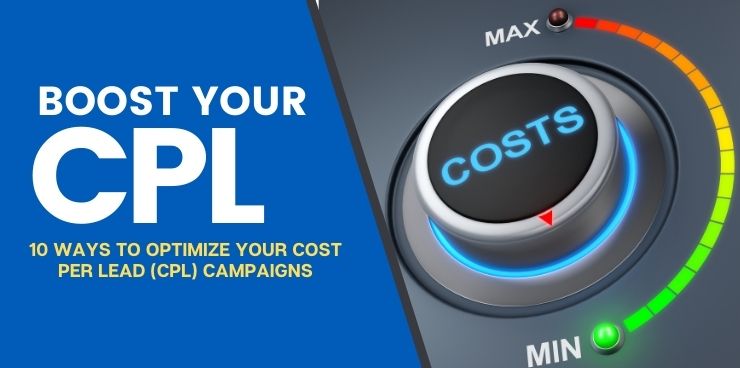When it comes to any business venture, you have to spend money to make money. From developing new products to producing them and finally selling them, it all requires capital. Marketing helps ensure that your business sees a profit from this investment. And the better you can budget for your marketing campaign, the more success you will see.
Understanding cost per lead (CPL) will help you better adjust your online marketing campaign. CPL, cost per click (CPC), cost per action (CPA) or cost per thousand (CPM) help determine a campaign’s cost-effectiveness.
What is Cost Per Lead (CPL)?
Cost per lead refers to how much it costs to gain a new prospective buyer from your marketing campaign. All marketing expenses aim towards the goal of lead generation. The term cost per lead helps you visualize if your campaign actually works.
CPL really only works when analyzing the effectiveness of your marketing efforts in terms of attracting customers. Of course, once you have the leads, closing the deal falls on your sales teams’ shoulders. CPL helps you check the health of your marketing while cost per sale helps determine profitability.
How to Calculate Your Cost Per Lead
You can calculate CPL using the cost per lead formula: CPL = Total Ad Spend / Total Leads Attributed. This formula works best when looking at a specific marketing campaign. This way, you can determine which campaign—and which methods—yield the best results.
The cost per lead calculator can give some really good insight regarding potential adjustments. In general, you want to have the lowest cost per lead possible. However, you also still need to keep the leads incoming in a great enough volume to yield a profit. You might find that the cheapest campaign yields negligible results, but its low price gives it a low CPL.
Though this cheapest CPL campaign cannot support your whole business, it may still teach you a thing or two.
 Ways to Reduce the Cost of Your CPL Campaign
Ways to Reduce the Cost of Your CPL Campaign
Now, when it comes to creating a better marketing campaign, certain steps can be taken to optimize it. Employ these methods all at once or implement them one at a time to better track their results. An expert consultant will help you really get the most out of a CPL marketing analysis.
Create Personalized Campaigns
When your advertisements match up with your landing pages, you tend to see an uptick in results. Message matching refers to ensuring that the titles of your ads match up with their associated landing pages. The best titles often include the same keywords a customer will have searched for. From there, the landing page should contain these same keywords in their own title.
For instance, you might have an advertised webpage with the title “Best Photography in Townsville, USA.” When a lead clicks on this link, the landing page should reiterate the “Best Photography in Townsville, USA” angle. Customers love consistency. Spending a little bit of extra time to create unique landing pages for all of your ads draws customers in.
When a customer sees a generic landing page that does not specifically relate to their search, they lose interest. No matter how good your product or service, your generic campaigns do nothing to help your business.
Aim for Lead Generation
Keeping the goal of your campaigns centered around lead generation can greatly increase the success of your marketing efforts. Lead generation refers to capturing a prospect’s contact information to line up a sale down the road.
Social media platforms, such as Facebook, have built-in tools to help businesses create a more effective marketing campaign. This makes a lot of sense since a successful ad campaign on Facebook means a business will stay around. While implementing a marketing campaign, Facebook will inquire about the goal of the campaign. You can select lead generation and then create ads centered around this goal.
Many businesses find that social media sites give them plenty of leads for a very low cost. Social media marketing campaigns allow prospects to engage with advertisements all from one website. And since social media users often input their demographics into their profile, you can easily sort through the best candidates.
Get Specific About Your Target Audience
Some marketing campaigns aim to do nothing except to raise general awareness. While this might work for some businesses with a near-universal audience, most businesses cater to much smaller groups. So, instead of casting a wide net and capturing an audience totally uninterested in your product, get specific.
Create advertisements geared toward a specific audience, making them feel like the ads call to them directly. For example, a hardware store could launch a campaign for a general home improvement audience. This leaves a vague impression on a large group of people. But when they focus on selling tools for Father’s Day, they create a greater impact on fewer people.
Campaigns focused around a smaller group make that group feel better attended to. This, in turn, results in more prospects taking the desired action. You can even make your campaigns appeal to a smaller group to increase the quality of all of these leads.
Craft Ad Copy With Audience Targeting
Ad copy helps convey the reasons your audience should buy your product. Using the right keywords is a sure-fire way to lead your target audience to the ads that appeal to them the most. Additionally, your ad copy will help filter through the leads to make sure you only generate the highest quality leads. Putting a specific call to action, such as, “If you intend to start a business…” will help you hone in on serious prospects.
Ad copy comes with the benefit of virtually endless creative potential. You can create funny or serious copy, depending on the group you wish to connect with. Creating a mood through your ad copy and coupling it with a call to action helps it truly speak to customers. Listing the direct benefits of leaving contact information helps customers see the immediate results of the exchange.
Keep your marketing team staffed with a core group of competent copywriting experts to drive your campaigns towards success.
 Target Visitors Based on Online Behavior
Target Visitors Based on Online Behavior
Most websites feature cookies to help identify a website visitor’s online behavior. Cookies act as a way to track what each visitor does, including which page they visit and for how long. Using this gathered data, implement advertisements that appeal directly to this group. This kind of data cataloging works exceptionally well for retargeting campaigns, wherein you attempt to capitalize on repeat visitors.
When you see your website visitors take the desired action after viewing a certain page, spread that success. Try to put this webpage at the forefront of your marketing campaign to increase the number of visitors.
Many tools exist to track visitor behavior and register it within your customer relationship management (CRM) system. These programs track all sorts of customer behavior. With this information, you’ll get a better idea of the driving forces behind your success or lack thereof.
Optimize Website
Interestingly enough, your website can be your own worst enemy. From broken links to slow connection speeds, anything that keeps your visitors from an enjoyable experience keeps your sales down. Known as friction, it frustrates and scares customers away, immediately leaving a bad impression. You want to make sure your website appeals to its customers in as many ways as possible, including load speed.
Having tons of high-quality images definitely makes your website look organic and well-designed. Too many pictures and your website appears cluttered and might increase load speeds.
Keeping your website both visually and technically appealing gives prospective customers a frictionless experience. When a customer clicks on your ad, they should wait no longer than two seconds for the site to load. The longer the load time, the less likely a visitor will stick around. You can upgrade your load speeds by using a simple design or upgrading servers.
Perform a Retargeting Campaign
Retargeting means continuing with a marketing campaign after making initial contact. Not every visitor will become a customer or even a lead from their first visit. It may take several visits or views before the customer decides to take the desired action. Social media marketing can help your business run a retargeting campaign based on a prospect’s actions.
Let’s say that a social media user views a department store ad and looks at pants. They might not decide to make a purchase at that initial time. But their interest in a specific product gives the store something to work with. Now instead of generic ads for the store, the prospect will see ads based on the product that they viewed.
This way, when the customer is finally ready, the store can close the deal sooner.
Check Variables: Time, Device, Location
Your ad performance can vary depending on a number of outside variables. The top three of which are time, device and location. Time: when do you generate most leads? Device: which platform for most leads use? Location: where are the leads located?
Keeping these variables in mind can help you tune your efforts with the actions of your customers.
A/B Test Everything
A/B testing, or split testing, is a good way to gauge the performance of one web page versus another. An A/B test means to give a trial group two versions of the same advertisement or web page. The group picks the most appealing version, and you use the data to adjust your web pages. Making data-based decisions allows you to choose the optimal logo, see which forms yield the best results and create stronger copy.
Reduce Lead Forms
Lead generation does not often mean going right for the sale. Instead, it means that a business focuses on increasing its pool of leads. This means obtaining some sort of contact information from as many prospective customers as possible. Lead forms often take the most popular form of customer acquisition through lead generation.
When you want to gather information, keep the forms as limited as possible. Sometimes, a pop-up will open as soon as a visitor enters a website, asking only for an email address. Given their to-the-point nature, the pop-up fields take very little time to fill out. However, they also capture very little information about the lead.
A more in-depth lead form asks more questions, and are therefore longer, but they tend to result in higher-quality leads. You want to balance these two objectives and place your forms where they capitalize on higher-quality leads. Keep them simple and efficient, gathering only what you need to know. Drop the form in the right spot, say, just past your landing page, and you might even see better results.
Figuring out the Right CPL Campaign
Sometimes your marketing efforts will be in such a messy state that you do not even know where to begin. Or maybe you just want to make sure you are taking the right steps. No matter your industry or experience, Selling Revolution can help increase your profitability.
From increasing leads to improving your sales process, you can count on Selling Revolution to deliver. Schedule a no-obligation, 20-minute phone consultation to discuss your current position and where you want to be. The sooner you get started, the sooner you can join the revolution!


 Ways to Reduce the Cost of Your CPL Campaign
Ways to Reduce the Cost of Your CPL Campaign Target Visitors Based on Online Behavior
Target Visitors Based on Online Behavior